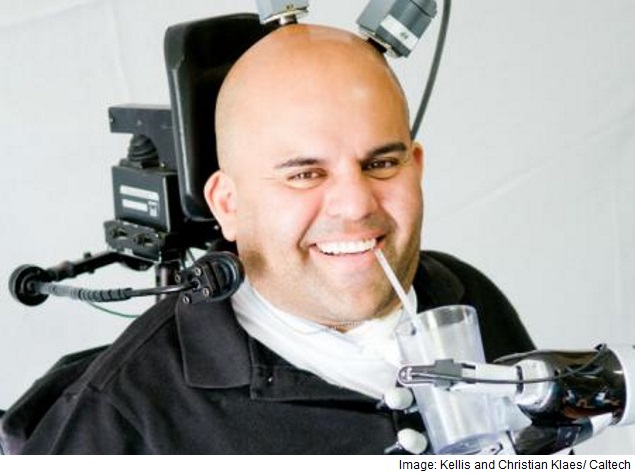- Home
- Science
- Science News
- Mind Controlled Prosthetic Limbs Allow Precise, Smooth Movement
Mind-Controlled Prosthetic Limbs Allow Precise, Smooth Movement

"That was the ultimate goal: to drink a beer by myself," said Sorto, a 34-year-old from Los Angeles who became a quadriplegic after a 2002 gunshot wound.
Things may be looking up for Sorto and others with similar disabilities. Scientists on Thursday described a better way to harness mind power to move prosthetic limbs.
Microelectrodes, implanted in the part of the brain that controls a person's intention to perform a movement, enabled a patient to fluidly guide a robotic arm, they said.
In a study published in the Science journal, surgeons at Keck Medicine of the University of Southern California placed a pair of small electrode arrays into Sorto's posterior parietal cortex, or PPC.
These neural prosthetics were then connected to computers that processed Sorto's brain signals and determined his intent, allowing him to control a robotic arm mounted to a table nearby, or a computer cursor.
"Mr. Sorto was able to learn to grasp different objects, play 'rock-paper-scissors,' play video games, drink a beverage," said California Institute of Technology neuroscientist Richard Andersen, who led the study.
"The PPC is a rich source of signals that can be used to determine the goals of a paralysed subject," said Andersen. "These signals can be used to control 'smart' robotics and computers that can work out the details of movement of external devices such as a robotic limb."
Neural prosthetic devices have previously been implanted in paralysed patients' motor cortex, the part of the brain that directly controls body movement. However, while those patients could control a robotic limb, movement was delayed and jerky.
Implanting the neuroprosthetics in the part of the brain that controls the intent to move yielded a more natural motion.
Sorto said he had a few tasks lined up.
"On the top of the list is that I want to be able to groom myself. I want to be able to brush my teeth by myself," he said.
And he was indeed able to drink his own beer.
"When I was able to do it with the robotic arm, it just reassured me that somehow in the future, people with my disability will be able to have some sort of independence," said Sorto. "And with that will come some sort of self-pride."
© Thomson Reuters 2015
Get your daily dose of tech news, reviews, and insights, in under 80 characters on Gadgets 360 Turbo. Connect with fellow tech lovers on our Forum. Follow us on X, Facebook, WhatsApp, Threads and Google News for instant updates. Catch all the action on our YouTube channel.
Related Stories
- Samsung Galaxy Unpacked 2025
- ChatGPT
- Redmi Note 14 Pro+
- iPhone 16
- Apple Vision Pro
- Oneplus 12
- OnePlus Nord CE 3 Lite 5G
- iPhone 13
- Xiaomi 14 Pro
- Oppo Find N3
- Tecno Spark Go (2023)
- Realme V30
- Best Phones Under 25000
- Samsung Galaxy S24 Series
- Cryptocurrency
- iQoo 12
- Samsung Galaxy S24 Ultra
- Giottus
- Samsung Galaxy Z Flip 5
- Apple 'Scary Fast'
- Housefull 5
- GoPro Hero 12 Black Review
- Invincible Season 2
- JioGlass
- HD Ready TV
- Laptop Under 50000
- Smartwatch Under 10000
- Latest Mobile Phones
- Compare Phones
- Realme P4x 5G
- OnePlus Ace 6T
- Nubia Flip 3
- Nubia Fold
- OPPO A6x 5G
- Samsung Galaxy Z TriFold
- Poco F8 Ultra
- Poco F8 Pro
- Asus ProArt P16
- MacBook Pro 14-inch (M5, 2025)
- Poco Pad M1
- Poco Pad X1
- Just Corseca Skywatch Pro
- Honor Watch X5
- Acerpure Nitro Z Series 100-inch QLED TV
- Samsung 43 Inch LED Ultra HD (4K) Smart TV (UA43UE81AFULXL)
- Asus ROG Ally
- Nintendo Switch Lite
- Haier 1.6 Ton 5 Star Inverter Split AC (HSU19G-MZAID5BN-INV)
- Haier 1.6 Ton 5 Star Inverter Split AC (HSU19G-MZAIM5BN-INV)
-
 Bitcoin Steadies Around $91,300 as Crypto Market Sentiment Remains Cautious
Bitcoin Steadies Around $91,300 as Crypto Market Sentiment Remains Cautious
-
 Motorola Edge 70 India Launch Date Announced; Confirmed to Feature Triple 50-Megapixel Camera Setup
Motorola Edge 70 India Launch Date Announced; Confirmed to Feature Triple 50-Megapixel Camera Setup
-
 Battlefield 6's 'Winter Offensive' Update Launches This Week With New Content, Audio Improvements and More
Battlefield 6's 'Winter Offensive' Update Launches This Week With New Content, Audio Improvements and More
-
 Chinese Brands Aiming to Win Users with AI Features That Apple Lacks: Report
Chinese Brands Aiming to Win Users with AI Features That Apple Lacks: Report










